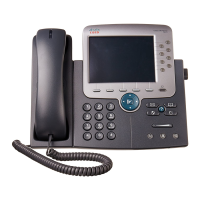Configuration files also contain information about the image load that the phone should be running. If this
image load differs from the one currently that is loaded on a phone currently, the phone contacts the TFTP
server to request the required load files. These load files are digitally signed to ensure the authenticity of the
file source.
In addition, if the device security mode in the configuration file is set to Authenticated and the CTL file on
the phone has a valid certificate for Cisco Unified Communications Manager, the phone establishes a TLS
connection to Cisco Unified Communications Manager. Otherwise, the phone establishes a TCP connection.
For SIP phones, a TLS connection requires that the transport protocol in the phone configuration file be set
to TLS, which corresponds to the transport type in the SIP Security Profile in Cisco Unified Communications
Manager Administration.
If the device security mode in the configuration file is set to Authenticated or Encrypted but the phone
has not received a CTL or ITL file, the phone tries four times to obtain the file so it can register securely.
Note
Cisco Extension Mobility Cross Cluster is an exception, in that the phone permits a TLS connection to
Cisco Unified Communications Manager for secure signaling even without the CTL file.
Note
If you configure security-related settings in Cisco Unified Communications Manager Administration, the
phone configuration file contains sensitive information. To ensure the privacy of a configuration file, you
must configure it for encryption. For more information, see the Cisco Unified Communications Manager
Security Guide, “Configuring Encrypted Phone Configuration Files” chapter.
A phone requests a configuration file whenever it resets and registers with Cisco Unified Communications
Manager.
A phone accesses a default configuration file named XmlDefault.cnf.xml only when the phone has not received
a valid Trust List file that contains a certificate assigned to Cisco Unified Communications Manager and
TFTP.
If autoregistration is not enabled and you did not add the phone to the Cisco Unified Communications Manager
database, the phone system rejects the phone registration request with Cisco Unified Communications Manager.
The phone displays the Configuring IP message continuously until you either enable autoregistration
or add the phone to the Cisco Unified Communications Manager database.
If the phone has registered previously, the phone accesses the configuration file named
SEPmac_address.cnf.xml, where mac_address is the MAC address of the phone.
For SIP phones, the TFTP server generates these SIP configuration files:
•
SIP IP Phone
◦
For unsigned and unencrypted files: SEP<mac>.cnf.xml
◦
For signed files: SEP<mac>.cnf.xml.sgn
◦
For signed and encrypted files: SEP<mac>.cnf.xml.enc.sgn
•
Dial Plan: <dialplan>.xml
•
Softkey Template: <softkey_template>.xml
Cisco Unified IP Phone 7975G, 7971G-GE, 7970G, 7965G, and 7945G Administration Guide for Cisco Unified
Communications Manager 9.0 (SCCP and SIP)
35
Cisco Unified IP Phones and Telephony Networks
Phone Configuration Files

